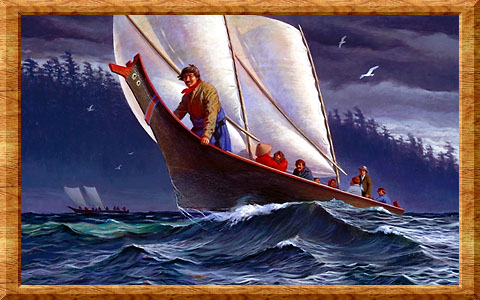
Original acrylic 24" x 36" by Bill Holm © 1988
Private collection
Western Washington travelling canoes, on the way to a potlatch, race over the waves before a November southwest wind at the turn of the century. The travellers relax and enjoy the ride, now passing through a welcome patch of afternoon sun. Only the steersman strains to keep the driving canoe off the wind. All the passengers are dressed in European fashion, typical of the period. The only visible example of traditional Native dress is the cedar bark hat worn by one woman.
Nineteenth-century Northwest Coast canoe sails were of canvas, sprit-rigged in imitation of the ships' boats of the early contact period. Many early explorers' journals mention making sails for the Indians they encountered, and describe teaching the canoe-men to use them. Earlier Native sails were probably square-rigged cedar bark mats that were used only in running before the wind. The newer design enabled canoes to sail with the wind on the beam as well. Most Northwest Coast canoes of moderate size or larger were fitted with sails after European contact. The "West Coast" or "Nootkan" style of canoe, seen here, was a very seaworthy craft and popular from the Columbia River to the north end of Vancouver Island as a travelling canoe.
PUBLISHED SOURCES:
Poster for the exhibition Indians of the Plains, Plateau, and Northwest Coast: Paintings by Bill Holm, Burke Museum, 1992.